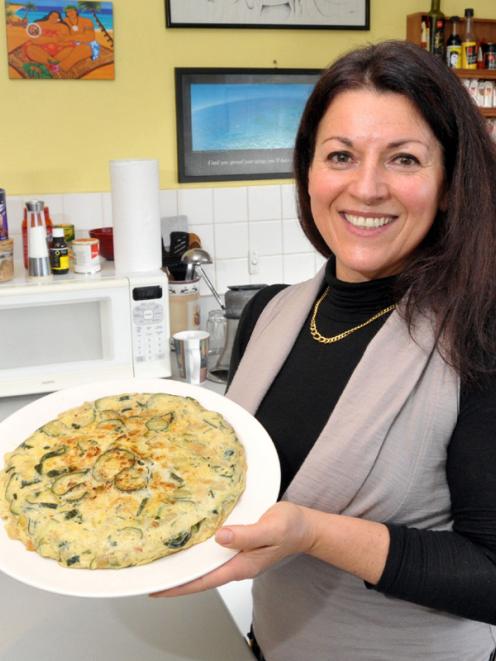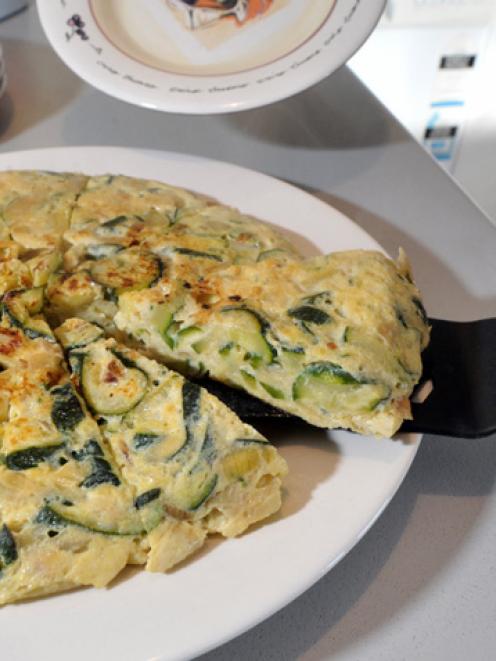Carmen Aliberch, from Madrid, shows how to make a Spanish omelette with zucchinis (courgettes).

She taught them how to use smell and sound as well as sight, taste and touch to judge how something was cooking and when it was done.
Grandma was queen of omelettes and could make one out of anything, but always said her zucchini omelette was the best in the world.
It is not quite as easy to make as a traditional potato omelette, as it is softer because of the liquid in the zucchini, but it is delicious, Carmen says.
With a salad and bread, this makes a good meal.
Grandma's tortilla de calabacin (zucchini omelette)

2-3 onions
5 zucchini (about 800g)
7 eggs
50ml sunflower or other oil
salt and pepper to taste
Peel and chop the onions into small cubes. Put them in the oil, stir and allow to cook and caramelise. You will be able to tell from the aromas when the onions are caramelising, but don't let them burn.
Wash and trim the ends off the zucchini. Slice thinly into rounds and add to the onions. Season to taste, stir and continue to cook until the vegetables have softened - this may take 20-25 minutes. For the last five minutes, remove the lid to allow the liquid that comes from the zucchini to evaporate. Meanwhile, whisk the eggs, either in a processor or with a whisk, adding a pinch of salt for each egg.
When the vegetables are cooked and smell good, drain off any liquid, or squeeze it out with your hands. Stir the vegetables into the eggs.
Heat a non-stick frying pan, about 26cm or larger, with some oil. Swirl the oil around to cover the base. It is important that the omelette does not stick.
When the pan is hot, ladle in some or all of the egg mixture. You do not want to make a zucchini omelette too thick, as it is soft and delicate and may break. It is better to make two thinner ones, she says.
With a wooden spoon, gently fold the mixture so the cooked egg moves to the top, allowing uncooked egg to flow to the bottom, to help it cook through evenly and so it does not burn on the bottom. Listen to the frying pan when you stir, as the egg will hiss as it cooks, she says.
Shake the pan from time to time to make sure the omelette is not sticking. You may have to move the pan on the element so it cooks evenly across the bottom.
When the top of the omelette is set and the bottom nicely browned and it smells good, turn the omelette over.
For this you need a large plate, bigger than the pan. Shake the omelette to make sure it is not sticking, put the plate on top of the pan, then quickly but carefully invert them so the omelette ends up on the plate.
Remove any bits of omelette stuck on the pan, and reoil it. Reheat the pan, then gently slide the omelette back so the side that is now on the bottom browns nicely.
When cooked, turn it on to the cleaned plate to serve.
Cut into seven wedges and serve hot or cold with a salad and bread to make a whole meal.
• This is best in summer when zucchini are in season and cheap. Aubergines also make a delicious omelette.
• Some people like to use more eggs, but Conchita used to say this was a good way to get children to eat vegetables, so she used lots of vegetables and fewer eggs.
• You can prepare the vegetables the day before so you can whip up the omelette quickly.
• If you are not confident you can turn the omelette over, make two thinner ones.
• Thanks to Afife Harris and Centre City New World.
